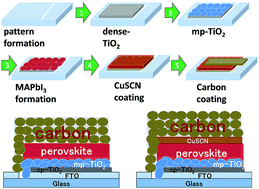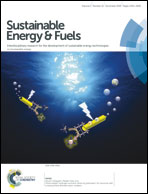Fabrication of fully non-vacuum processed perovskite solar cells using an inorganic CuSCN hole-transporting material and carbon-back contact
Abstract
Fully non-vacuum processed perovskite solar cells have been demonstrated using cheap inorganic copper(I) thiocyanate (CuSCN) as an efficient hole transporting layer in conjunction with low temperature processed carbon back electrodes. The CuSCN interlayer attained better energetic matching and assisted the easy release of holes, reducing the observed hysteresis. The fabricated PSC (F-doped SnO2 glass (FTO)/dense TiO2/porous TiO2/CH3NH3PbI3/CuSCN/carbon) was able to realize a power conversion efficiency (PCE) of 12.41%, measured under 100 mW cm−2 illumination with a short circuit current density of 18.90 mA cm−2, an open circuit voltage of 0.95 V and a fill factor of 0.68. An advantageous 68% of the initial PCE was retained for the unencapsulated PSC stored in air in the dark, measured over 4500 h. Although PSCs without a CuSCN interface retain their initial PCE after 185 days of ambient storage and 1000 h of dark thermal stress (85 °C), the PCEs of perovskite solar cells with CuSCN undergo significant deterioration.

- This article is part of the themed collection: Perovskite solar cells


 Please wait while we load your content...
Please wait while we load your content...